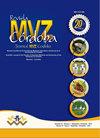Estado actual de Melongena melongena (Mollusca: Gastropoda) en la bahía de Cispatá, Caribe Colombiano
IF 0.3
4区 农林科学
Q4 AGRICULTURE, DAIRY & ANIMAL SCIENCE
引用次数: 0
Abstract
Objective. Evaluate the current status of Melongena melongena in Cispata Bay, Colombian Caribbean through the population aspects of the species. Materials and methods. Three sampling sectors were established, according to the zoning of the mangrove in the bay. For the collection of the biological material a linear transect of 4 x 20 m was located perpendicular to the area of the mangrove with two replicas at a distance of 50 m. For the determination of sex, a subsample of 10 individuals with sizes greater than that estimated for the sexual maturity of the species was taken. The shells were measured in total length, in order to differentiate the sizes of females and males. In each sector, the water temperature and salinity were recorded in situ, using an Extech EC170 multi-parameter meter, and the transparency of the water was calculated using the Secchi disk. Results. A total of 1,149 individuals of M. melongena were recorded, obtaining the highest abundance in the Cano Salado sector (522), followed by Las Cagas (458) and finally Amaya (169). 63% of the individuals were in a size range between 41-61 mm. The sex ratio was 1:1.2 (H:M). The sizes recorded in females were from 55 to 92 mm and in males from 54 to 77 mm. Conclusion. M. melongena in Cispata Bay has been showing evident signs of recovery in the last decade, considering that most registered individuals have reached the average height of sexual maturity.哥伦比亚加勒比Cispata湾Melongena Melongena(软体动物:腹足类)的现状
目标。从种群的角度评价哥伦比亚加勒比海西斯帕塔湾龙舌兰的现状。材料和方法。根据海湾红树林的分区划分,建立了三个采样区。为了收集生物材料,一个4 × 20米的线性样带垂直于红树林区域,在距离50米的地方有两个复制品。为了确定性别,取了10个个体的子样本,其大小大于该物种性成熟的估计。为了区分雌性和雄性的大小,测量了壳的总长度。在每个区域,使用Extech EC170多参数测量仪现场记录水温和盐度,并使用Secchi圆盘计算水的透明度。结果。其中,卡诺萨拉多区(522只)丰度最高,拉斯卡加斯区(458只)次之,阿玛亚区(169只)次之。63%的个体体长在41 ~ 61毫米之间。性别比为1:12 .2 (H:M)。雌性记录的大小为55至92毫米,雄性记录的大小为54至77毫米。结论。考虑到大多数登记的个体已经达到性成熟的平均高度,西斯帕塔湾的M. melongena在过去十年中已经显示出明显的复苏迹象。
本文章由计算机程序翻译,如有差异,请以英文原文为准。
求助全文
约1分钟内获得全文
求助全文
来源期刊

Revista Mvz Cordoba
农林科学-奶制品与动物科学
CiteScore
0.70
自引率
0.00%
发文量
41
审稿时长
6-12 weeks
期刊介绍:
The Journal MVZ Córdoba is an open access international scientific journal financed and edited by the University of Córdoba (Colombia). The journal publishes quarterly, continuously in PDF, XML, Epub, original articles, literature reviews, brief communications and clinical cases, peer-reviewed (double-blind) in Spanish and English, which are related to the agricultural and veterinary sciences. The journal is directed to natural and legal persons of veterinary medicine, animal husbandry, public health, epidemiology, aquaculture, biology, basic biomedical sciences and biotechnology and constitutes a space for academic and scientific discussion around the work of professionals in Veterinary Medicine and Zootechnics. Four-monthly publication.
"The Journal MVZ Córdoba supports the policies for registration of clinical trials of the World Health Organization (WHO) and the International Committee of Medical Journal Editors (ICMJE), since it recognizes the importance of these initiatives for international registration and dissemination. of information about clinical studies, in open access. As a result, since 2007, the journal MVZ Córdoba only publishes clinical research articles that have received an identification number in one of the Clinical Trial Registries validated by the criteria established by WHO and ICMJE, whose addresses are available in the ICMJE website. The identification number is recorded at the end of the summary. "
 求助内容:
求助内容: 应助结果提醒方式:
应助结果提醒方式:


